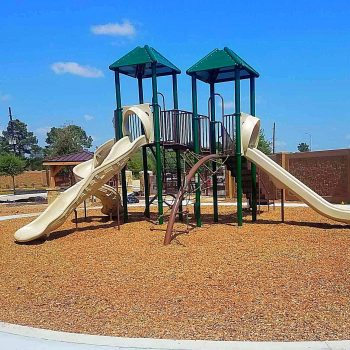Playground Resurfacing: Important Safety Factor to Reduce Injuries
Posted by May Recreation Content Team on

Playgrounds are a place of joy and exploration for children, but ensuring their safety is paramount.
While a lot of attention is paid to the actual playground equipment installed, one often overlooked aspect of playground safety is the surface material.
“A proper playground surface is one of the most important factors in reducing injuries and the severity of those injuries,” explains Randy May of May Recreation. “The surface under the playground equipment should be soft enough and thick enough to soften the impact of a child’s fall.”
Playgrounds, like any other outdoor structures, are subject to natural wear and tear due to weather, foot traffic, and ongoing use. As a result, the need for playground resurfacing is a common issue faced by many playgrounds across the United States.
Playground resurfacing then can play a critical role in minimizing injuries and enhancing accessibility, especially when upgrading an older, harder surface.
“Today, safety experts recommend “softer” playground surfacing options, which serve to absorb some of the impacts by cushioning the child’s fall,” said May. “The proper playground surface can dramatically improve playground safety.”
Playground Resurfacing Standards and ASTM Guidelines
The American Society for Testing and Materials (ASTM) has established standards to ensure the safety and accessibility of playgrounds since 1992.
ASTM F1292 is the standard specification for the impact attenuation of playground surfacing materials, outlining the criteria for impact testing to assess a surface's ability to absorb shock from falls.
The International Play Equipment Manufacturers Association (IPEMA) utilizes ASTM standards when evaluating playground equipment for public use. They ensure that playground equipment manufacturers meet these standards for safety, and this includes the quality of the surfacing material used under and around the play equipment.
Compliance with these standards is crucial to minimize the risk of injuries due to falls.
Here's a more detailed explanation of ASTM F1292:
- ASTM F1292 Purpose: ASTM F1292 was developed to address the risk of injuries resulting from falls on playground surfaces. It establishes the criteria for conducting impact testing to assess how well a surface material absorbs the shock from falls, minimizing the potential for severe injuries.
- Critical Fall Height: The standard is primarily concerned with determining the "critical fall height." This is the maximum height from which a child can fall without suffering a life-threatening head injury. ASTM F1292 defines the specific parameters for conducting tests to measure the critical fall height of a playground surface.
- Drop Test Procedure: ASTM F1292 prescribes a drop test procedure involving a specially designed test instrument known as the Triaxial Accelerometer. The instrument is dropped from various heights onto the playground surface, and the resulting impact measurements are recorded.
- G-Max Value: The standard establishes the G-Max value, which is a measure of the maximum acceleration experienced during the impact. A lower G-Max value indicates better shock absorption and reduced risk of injury.
- HIC (Head Injury Criterion): ASTM F1292 also introduces the Head Injury Criterion (HIC), a calculation based on the deceleration experienced by a test head form during impact. A lower HIC value indicates a reduced risk of head injuries.
Common Playground Resurfacing Solutions
Playground operators have a variety of resurfacing solutions, each with their advantages and disadvantages:
Engineered Wood Fiber
Composition: Engineered wood fiber is typically made from shredded wood, often sourced from hardwood trees. It is processed to specific standards, ensuring uniform particle size. The fibers interlock, creating a cushioned surface that absorbs impact.
Pros: Natural appearance, cost-effective, excellent impact absorption.
Cons: Requires regular maintenance, can deteriorate over time, and may not be suitable for all weather conditions.
Loose Rubber
Composition: Loose rubber surfaces are made from shredded or granulated rubber, commonly sourced from recycled tires. The rubber granules are evenly distributed across the playground area to provide a soft and shock-absorbing surface.
Pros: Good impact absorption, accessible for children with mobility aids, relatively low maintenance.
Cons: Can scatter and need periodic replenishment, initial cost may be higher.
Poured-In-Place (PIP) (Rubber and Polyurethane)
Composition: PIP rubber and polyurethane are a combination of a base layer of recycled rubber and a top layer of polyurethane. The rubber base provides support and impact absorption, while the polyurethane top layer creates a smooth, seamless surface with vibrant color options.
Pros: Seamless and visually appealing, excellent shock absorption, durable.
Cons: Higher initial cost, installation requires professional expertise.
Rubber Tile
Composition: Rubber tiles are manufactured from vulcanized rubber granules, often derived from recycled materials. These tiles interlock to form a stable and slip-resistant surface. They are available in various thicknesses and colors to suit the playground's needs.
Pros: Attractive appearance, ease of maintenance, good impact absorption.
Cons: Can be expensive, tiles may become loose over time, and occasional replacement may be necessary.
Bonded Rubber
Composition: Bonded rubber surfaces are typically composed of shredded or granulated rubber mixed with a binding agent, often polyurethane. This mixture is applied directly to the playground area, where it bonds and cures to create a seamless, cushioned surface.
Pros: It's low maintenance, highly durable, and can be customized in terms of color and design.
Cons: The initial cost can be relatively high, and installation requires professional expertise. Bonded rubber surfaces may also heat up in direct sunlight, making them less suitable for extremely hot climates.
Artificial Turf
Composition: Artificial turf surfaces consist of synthetic fibers (typically polyethylene or nylon) stitched into a backing material. This backing is filled with an infill material, which can be made of sand, crumb rubber, or a combination of materials. The infill provides stability and helps simulate the feel of natural grass.
Pros: Aesthetically pleasing, low maintenance, suitable for various climates.
Cons: Limited impact absorption, can become hot in the sun, may require regular cleaning.
Each resurfacing solution has its own set of advantages and disadvantages, and the choice often depends on budget, maintenance capacity, and specific playground requirements.
Factors Influencing Playground Resurfacing Choices
Selecting the most suitable playground resurfacing solution requires careful consideration of several factors.
The location, purpose, type of playground equipment, the age of children using the playground, and budget constraints all play a crucial role in determining the optimal surface solution:
- Location: The geographical location of the playground is a significant factor. Weather conditions, such as temperature and precipitation levels, will affect the choice of resurfacing material. For example, artificial turf may be a better option in areas with harsh weather conditions, whereas loose rubber might be preferable in more temperate climates.
- Purpose of the Playground: The intended purpose of the playground also influences the choice of surface material. Playgrounds designed for general recreation may opt for cost-effective options, while those meant for athletic activities may require a more specialized surface, like poured-in-place rubber, to support those specific activities.
- Type of Playground Equipment: The nature and variety of playground equipment can determine the best resurfacing solution. Equipment with higher fall heights may require surfaces with superior impact absorption, such as PIP rubber or bonded rubber. Playground equipment featuring slides or swings may benefit from rubber tile surfaces that offer both cushioning and stability.
- Age of Children Frequenting the Playground: The age group of the children who will use the playground should be considered. Toddler playgrounds catering to younger children may prioritize softer surfaces that are gentle on developing bones and joints. On the other hand, older children may need surfaces with higher impact resistance due to increased activity and adventurous play.
- Budget Constraints: Budget is a crucial factor when choosing a resurfacing solution. While some materials, like engineered wood fiber or loose rubber, may be more budget-friendly initially, others, such as PIP rubber or bonded rubber, may come with higher upfront costs but offer long-term cost savings through reduced maintenance and increased durability.
- Accessibility and Inclusivity: Ensuring accessibility for children with varying abilities should be a top consideration. Resurfacing materials like loose rubber, PIP rubber, or bonded rubber are designed to accommodate mobility aids and promote inclusivity.
- Aesthetics and Design: The visual appeal of the playground is another factor. Rubber tile, artificial turf, and bonded rubber offer customization options for colors and designs, which can enhance the overall aesthetics of the playground.
- Maintenance Requirements: Different materials have varying maintenance needs. Loose rubber, for instance, may require periodic replenishment, while engineered wood fiber may need regular raking and topping up. Consider the available maintenance resources and schedules when choosing a surface solution.
- Local Regulations and Codes: Compliance with local safety and accessibility regulations is non-negotiable. It's imperative to ensure that the chosen resurfacing material meets all relevant safety standards and codes.
The choice of a playground resurfacing solution should be a carefully considered decision based on the specific needs, circumstances, and objectives of the playground.
Playground Resurfacing: Prevalence and Lifespan
It's safe to say that at some point in time, nearly every playground in the U.S. will require resurfacing.
The frequency and urgency of resurfacing depend on various factors, but maintenance and renewal are recurring concerns for playground operators.
The lifespan of a playground surface varies depending on the material used and how well it's maintained. Here's a general estimate of the typical lifespans for common resurfacing materials:
- Engineered Wood Fiber: With proper maintenance, engineered wood fiber can last around 5 to 10 years. However, it may require replenishment every 1 to 2 years to maintain impact-absorbing qualities.
- Loose Rubber: Loose rubber surfaces can last between 5 to 10 years or more, depending on maintenance and usage levels. Periodic redistribution of the rubber granules may be necessary.
- PIP (Rubber and Polyurethane): PIP rubber and polyurethane surfaces have a longer lifespan, often lasting 10 to 20 years. Regular inspections and maintenance are still essential for maximizing durability.
- Rubber Tile: Rubber tile surfaces are known for their durability, with a typical lifespan of 15 to 20 years or more. They require minimal maintenance.
- Bonded Rubber: Bonded rubber surfaces are highly durable, often lasting 15 to 20 years. Proper installation and maintenance can extend their lifespan.
- Artificial Turf: Artificial turf can last for 10 to 15 years or more, with regular cleaning and maintenance. However, UV exposure and high traffic may impact its longevity.
It's important to note that these are general estimates, and the actual lifespan of a playground surface can vary widely depending on factors like climate, usage, and maintenance.
Regular inspections and proactive maintenance can help extend the life of the playground surface and ensure the safety of the children who enjoy it.
